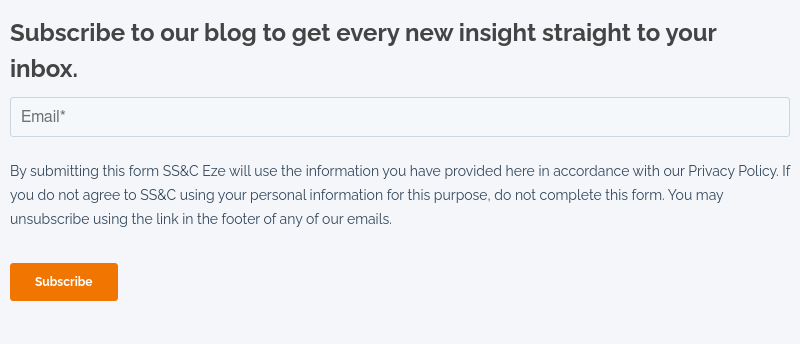The decision to transition to new investment technology can be daunting for many firms. The mere prospect of change often triggers a cascade of concerns and questions that can delay the changes necessary to improve firms’ operations – even when existing systems are costing them time, money, and opportunities.
Here are just some of the concerns I’ve heard from investment managers thinking about replacing their investment technology:
“What if the transition disrupts my operation, and I can’t get my orders processed?”
“After all that work, what if the new system isn’t much better than the old one?
“It’s my responsibility to ensure the transition is successful, so what if it isn’t?”
While it is true that moving to a new investment technology has the potential to be disruptive, in my experience, the reality is often easier than many investment managers imagine.
To give firms the confidence to take the first step in improving their operations, I wanted to address 3 of the top myths about switching systems and provide insight into what it’s really like to change investment management technology.
Is your investment technology costing your firm time, money, or opportunities? Find out with this 4-question quiz.

Myth 1: Switching Investment Systems Will Disrupt Front-Office Operations Causing Lasting Fallout
Among the foremost concerns for firms contemplating a technology conversion is the potential disruption it poses to their front-office operations.
Fear of upheaval or inefficiencies causing missed opportunities and a lasting impact on performance looms large for investment managers, often dissuading them from making the move to a new, improved system.
Reality: Preparation and Comprehensive Support Minimize Implementation Disruptions
The potential for disruption in an investment technology transition is minimized when the conversion is meticulously planned.
Before work starts, ask your vendor to create a detailed schedule that outlines how long the process will take and how they will ensure timely delivery. Your vendor should also be able to provide details on what disruptions may arise and provide contingency plans if something goes awry.
Ideally, you’re working with an adept vendor with robust conversion experience and the infrastructure needed to easily accommodate this ask.
Also ensure you receive comprehensive before-, during-, and after-conversion support and training that aligns your new technology with your current processes, particularly in the front office. Partnering with your new vendor in this way will significantly reduce your technology transition’s impact on day-to-day operations and help ensure opportunities are not lost in the process.
Myth 2: Moving to a New Investment System Can Only Offer Minimal Functional Advantages
Some firms hesitate to adopt new technology because they are skeptical about the tangible benefits it will offer compared to their existing systems. Why do all that work if the features and functionality are pretty much the same?
Reality: Truly Impactful Technology is Available, but Due Diligence is Key to Recognizing It
The investment landscape is changing quickly, and good vendors rapidly update their technology to keep pace. From improved user interfaces to enhanced automation and data tools, developments in investment technology can unlock avenues for increased opportunities and efficiencies.
Of course, before moving to a new system, it is critical to perform due diligence to ensure the functionality of any new system aligns with your organizational needs and is a true improvement on existing systems.
Vendor demos will be a critical part of that assessment. These demos should give you a clear understanding of how a solution will support your specific workflows – and your overall efficiency.
During the demo, never hesitate to ask your potential vendor to break from their standard script and show you exactly how their system executes your investment ideas and manages downstream operations.
Unsure of what to expect in the conversion process? Dive deeper in this 3-phase tactical guide for switching.
Myth 3: Managing an Unsuccessful Technology Transition Could be Detrimental to My Career
Implementing a new solution can be challenging, and the process can be doubly daunting when you are migrating workflows and data from - and will ultimately offboard - an existing system. Perhaps the most daunting, though, is being the one responsible for the success of this entire process.
Those leading technology conversions often fear that if the transition to new technology doesn't go well, it could jeopardize their role within the firm.
Reality: The Right Partner Enables Successful Technology Transitions and Ongoing Process Improvements
With the right technology partner, your vendor’s implementation team will act as an extension of your firm – supporting you at every step of the process, matching your commitment to a successful outcome, and making sure you never feel alone.
To find such a vendor, in your search, ask exactly how much, when, and how they will support you throughout the switch. Ask what their commitment to a successful conversion is. Ask to meet the key members of your implementation team as soon as the contract is signed (or sooner) and ask them to detail the upcoming process.
Establishing critical lines of communication with your conversion team early ensures they will be accessible throughout every phase of the launch and beyond, setting you up to not only lead a successful technology transition but also become known for spearheading overall process improvements contributing to your firm's success.
As SS&C, we recognize the importance of a strong line of communication before, during, and after you transition to Eze technology. Project managers oversee all implementations and use proven project management methodology to keep all aspects of technology conversions on track and on schedule. The workflow is thoroughly documented, and an online portal gives users full transparency into the status of their project.
Embracing Change to Enhance Long-term Outcomes
Switching your investment management systems is a big undertaking that is not without challenges.
But by working with a technology vendor that provides detailed project management, innovative technology, and a dedicated team of conversion experts, many of investment managers’ biggest concerns about the process never come to fruition.
Embarking on a technology transition can drive organizational and personal growth, and I hope that by dispelling some of the top myths about this process, I’ve inspired you to view your upcoming technology conversion as an opportunity for evolution rather than a change to be feared.
To dive deeper into how you can successfully evaluate, choose, and implement a new investment system, download our latest guide: Switching Systems Simplified.


